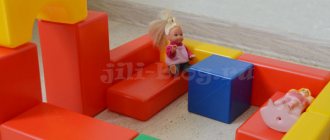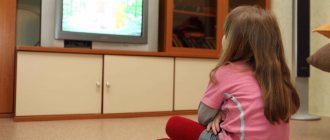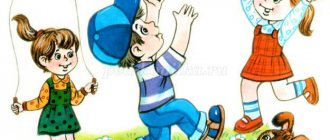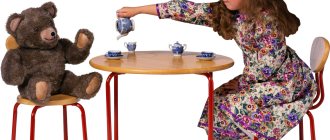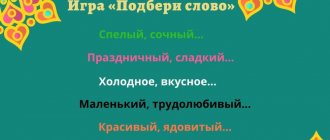Card index of role-playing games in the middle group.
"Polyclinic"Target:
Clarify and expand children’s understanding of the rules of behavior in public places and at clinic appointments; provide insight into the functioning of the human body
Materials, attributes, equipment:
White coats and caps for doctors, numbers for the cloakroom attendant, tables and a pointer for the ophthalmologist, an “X-ray” depicting the internal organs of a person, a phonendoscope, a thermometer and a device for measuring blood pressure for the therapist, a syringe
Progress of the game:
Educator: Today a clinic starts operating in our kindergarten. First of all, upon entering the clinic, you need to undress.
(Children imitate undressing, greet the cloakroom attendant, get a number, thank you)
Educator: Now let's go to the registration desk to get the cards. To receive it, you must provide your last name, first name and address.
(The children take the cards and go to the doctor. The teacher reminds them that they shouldn’t run or scream in the clinic, because people come there who don’t feel very well, and you shouldn’t cause them unnecessary trouble)
Educator: We came to the clinic today to undergo a medical examination, that is, to check whether our body is healthy. First we'll go to the eye doctor's office.
Oculist
(The children enter the office. The doctor takes turns checking the children’s vision using a table. All eyesight is good. He talks about the prevention of eye diseases - you can’t rub your eyes with dirty hands, if a speck gets into the eye, you need to gently stroke the eye towards the nose; tells why glasses are needed: medical glasses improve vision, sunglasses protect the eyes from the bright sun, diving glasses allow you to dive and view the underwater world)
X-ray room
The doctor asks the patient to undress to the waist and stand behind the screen. He takes a photograph, shows it and tells what it shows:
This tube is the esophagus, through which food enters the stomach.
This is the stomach, in which food is digested - useful and necessary substances are absorbed by the body, and unnecessary ones go further and are removed from the body.
These are the lungs - they receive the air we breathe.
This is the heart, it is constantly in motion - like a small pump, pumping blood throughout the body.
The doctor says that in order for all organs to be healthy, it is important to eat healthy food: vegetables and fruits, breathe clean air and exercise.
Otolaryngologist
The doctor examines the ears, throat and nose of the patients, talks about the prevention of ENT diseases: in order to keep the throat healthy, you should not eat ice cream in large pieces, it is harmful to breathe through the mouth - that is what the nose is for. You should not put small objects into your ears and nose - they can get stuck there and will only be removed in the hospital. You cannot listen to loud music or shout loudly, you need to use a handkerchief correctly.
Dermatologist
The doctor examines the patients: asks them to show their hands, stomach, and examines the scalp.
The doctor tells you how to take care of your skin: wash with hot water and soap and a washcloth at least once a day, wash your hands before eating and after visiting the toilet. You should not touch stray animals - you can become infected with a very unpleasant disease. You can only comb your hair with your own comb; you cannot try on other people’s hats - this is necessary so as not to become infected with insects - lice that live on a person’s head.
Therapist
Today we went to the therapist so he could examine us and tell us if everything was okay.
(The doctor measures the temperature, listens to the chest with a phonendoscope, and measures the pressure).
Doctor: Temperature and blood pressure are normal. The heart beats evenly, the lungs breathe well, there is no wheezing in them. You are healthy. But you need to get vaccinated to avoid getting sick. Go to the nurse.
(The nurse wipes her hand with a cotton swab and gives an injection)
Educator: Our visits to the doctors are over. We are healthy and we know how to behave in order to maintain our health.
LiveInternetLiveInternet
Junior group
List of games:
1st quarter: “Family”
,
“Kindergarten”
,
“Shop”
,
“Visiting the nesting doll”
,
“Puppet show” , “Mishka’s birthday”
,
“Bus”
,
“Let’s put the doll to bed”
,
“Moidodyr visiting the guys”
,
“With the doll Sonya” for a walk”
,
“The lunch hour has come”
.
2nd quarter: “Hospital”
,
“Barbershop”
,
“Big Laundry”
,
“At the Christmas Tree Festival”
.
Quarter 3: “Toy Store”
,
“Steamboat”
,
“Zoo”
,
“Chauffeurs”
,
“Talking on the Phone”
.
The rest of the games are more difficult.
Middle group
List of games:
1st quarter: “Sailors”
,
“At the dentist”
,
“Laundromat”
,
“Gegetable shop”
.
The rest of the games are more difficult.
2nd quarter: “Beauty salon”
,
“Birthday of Winnie the Pooh Bear”
, (Carlson,
“Theater”
,
“Excursion to the Museum”
,
“Puppet Theatre”
,
“Dining Room”
,
“Concert for Puppets”
.
3rd quarter – all games with more difficulty.
Senior group
List of games:
1st quarter: “Confectionery Factory”
,
“Shop”
(confectionery, bread, dairy,
“Polyclinic”
,
“Harvest”
,
“Steamboat”
(the work of river workers,
“Steamboat”
(we sail along the river Vorona, Khoper,
“Transport”
(land, air,
“Livestock breeders”
,
“ Journey to Atlantis or another planet”
,
“Journey to distant lands”
,
“Hospital with different departments”
,
“Pharmacy”
,
“Builders of the cosmodrome”
.
2nd quarter: “Building a city of the future”
,
“Airport”
,
“We are artists”
,
“Atelier”
,
“Circus”
,
“Adventure travel”
(on land, at sea,
“Border Guards”
,
“We are artists”
,
“Fishing boat”
,
“Library”
.
3rd quarter: “Building the city of Borisoglebsk”
,
“Animal hospital”
,
“Mail”
,
“Mom’s holiday at home”
,
“Space travel”
,
“We are circus performers”
,
“Newsstand”
,
“Cooking”
,
“Disco”
,
“Forest school”
,
“Spring ball”
,
“Street traffic”
,
“Premiere at the theatre”
,
“In the botanical garden”
.
Preparatory group
List of games:
1st quarter: “School”
,
“Travel to Russia”
,
“Toy Factory”
,
“Autumn Fair - Gifts of Nature”
,
“We are farmers”
,
“Library”
,
“Playing theatre”
,
“We are going to another country”
,
“Cannery
,
“Journalists”
,
"Photo Studio"
.
2nd quarter: "Stadium"
,
“Family”
(grandmother’s, grandfather’s anniversary or other family holiday,
“Cinema”
,
“Circus”
,
“Ambulance”
,
“Farewell to Winter”
,
“Television”
,
“KVN”
,
“I’m interviewing”
,
“Pantomime Theatre”
,
“Livestock Breeders”
,
“Sewing Studio”
,
“Railway”
,
“Space”
.
Quarter 3: “Fire Station”
,
“Emergency”
(burns, poisoning,
“Animal hospital”
,
“We are aliens”
,
“Morning Star”
,
“Carnival in Africa”
,
“Dentistry”
,
“Polyclinic”
(bites, injuries,
“Fashion House”
,
“Flight”) into space"
,
"Field of Miracles"
,
"Travel on a Bathyscaphe"
,
"Herbal Pharmacy"
,
"Stadium"
(sports games,
"Beauty Contest"
(clothing modeling,
"Emergency"
(foreign bodies, donors,
"Flight to the Moon "
,
"Dog Show"
,
"Border Guards"
.
Approximate distribution of role-playing games by year of study
First year of study
October, November, December, January, February - training in actions with various toys (dolls, animals - dog, cat, chicken, horse, hare, fox, squirrel, bear, hedgehog).
March, April, May - training in operations with engines (truck, train, bus).
Second year of study
October - sequential playing with the doll.
November, December - “Mothers and Daughters”.
January - “Bus”.
February - “Toy Store”.
March - “Family” (playing with a doll, bus trips, walks, visiting guests, etc.).
April - “Doctor” (doctor’s appointment in kindergarten).
May - “Kindergarten” (using the game “Bus” and “Family”).
Third year of study
September, October - “Toy Store” and “Grocery Store”.
November - "Doctor".
December - “Family” and “Bus” (combination of plots).
January – “Kindergarten”.
February - “Barbershop”.
March - “Calling a doctor to your home”, “Family”, “Shop”, “Hairdresser” (combination of plots).
May - “Puppet Theater” (the game includes dramatizations of fairy tales).
June - “Zoo”.
Fourth year of study.
September - “Store” (Supermarket). October - “Polyclinic”. November – “Polyclinic” and “Pharmacy”. December - “Call a doctor at home”, “Ambulance”. January – “Kindergarten”. February - "Sailors". March - "Mail".
April - “School” and “School Supplies Store” (plot combination). May - “Zoo”.
Approximate list of topics for playing with dolls (1st year of study
): “Our guest is the doll Anya (Vanya)”; “The doll wants to sleep”; "Anya's doll's breakfast"; "Dani Bear's Birthday"; "Baby Walk"; “Matryoshka has a housewarming party”; “Bathing naked babies”; "Wash"; "Christmas tree holiday"; “Matryoshka dolls came to our new house”; “The nesting dolls came to visit us”; “Let’s dress my daughter for a walk”; “Anya woke up (doll morning)”; “A trip to visit by bus”, etc.
Preparatory work: didactic games to clarify the names of objects and actions; reading children's literature.
An approximate list of topics for playing with animal toys
: “We’re going to visit the dog in the yard (doghouse...)”; “They gave us a kitten”; “Let’s feed our hen and chicks”; “Let's ride a horse”; “A walk in the forest (meeting the animals)”, etc.
An approximate list of topics for playing with motor toys
: “We’ll bring cubes on a truck to build a house”; “Housewarming” (transportation of furniture by truck); “Let's ride the animals on the train”; “Let’s ride the animals on the bus,” etc.
Approximate list of topics for the role-playing game “Family”
“: “Morning in the family”; "Lunch in the family"; "Evening with the Family"; "Family Day Off"; “A child in the family fell ill”; “We help mom wash clothes”; "Big house cleaning" “Family came to visit family”; “Moving to a new apartment”; “Holiday in the family: mother’s day, New Year, birthday, etc.”
Preparatory work: examination of the painting “Family” and “Washing Laundry” (see various sets of paintings for kindergartens); pictures “Object in action”, reading children's literature.
Attributes: dolls in images (mother, father, children, grandmother, grandfather, baby dolls), clothes for dolls; apartment equipment for dolls (kitchen and living room): wardrobe, sofa, bed, table, chairs, clothes hanger, kitchen furniture, stove, sink, dishes, ironing board, irons, basins, children's washing machine, vacuum cleaner, drying stand linen, clothespins, children's sewing machine, aprons for children, toy mixer, Little Housewife set, etc.
Approximate list of topics for the role-playing game “Kindergarten”
": "Admission of children to the group"; “A bus ride to kindergarten and admission of children to a group”; “Exercise in kindergarten”; “Nanny job in the morning - breakfast”; “Nanny's job - group cleaning”; “The work of a cook in a kindergarten”; “Working in the kindergarten laundry”; “The teacher conducts a lesson in kindergarten”; “A speech therapist conducts a lesson in a kindergarten”; “A teacher conducts a lesson in kindergarten” (children observe the work of a speech therapist or a speech pathologist and can accurately convey it); “The music director conducts a lesson in kindergarten,” etc.
Preparatory work: a set of sequential pictures (individual pictures or a screen) to familiarize a nanny, teacher, cook with the work; paintings from the “We Play” series (paintings for kindergartens); an excursion to the doctor’s office, the kitchen, the laundry room, observation of the work of the assistant teacher and teacher (in his group, in the younger group), music director, teacher, speech therapist, etc.; reading children's literature.
Attributes: dolls with a set of clothes, furniture, dishes, small toys, mops, buckets, rags, aprons, bathrobes, washing machine, basin, drying rack, ironing board, irons, gas stove, cookware set, food, vacuum cleaner, musical instruments, various games (for playing teacher and speech therapist), etc.
Approximate list of topics for the role-playing game “Bus”
": "Building a bus"; “Learning to drive a bus”; “We’re going to kindergarten”; “We’re going to the park”; “Riding around the city”; “We’re going to visit”; “We’re going to the theater,” etc.
Preparatory work: examination of the paintings “The Driver” (from the series “Who to be?”), “Riding on the Bus” (from the series “We Play”), various illustrations, pictures about transport, etc.; excursion to the bus stop, observation of the bus and the driver’s work; reading children's literature.
Approximate list of topics for the role-playing game “Shop
“: vegetable, grocery, bread, clothing, toy store, etc. The game “Department Store”, “Universam” is organized with children of senior preschool age.
Preparatory work: examination of the painting “Seller” from the series “Who should I be?”; a set of sequential pictures (individual pictures or a screen) to familiarize the seller and cashier with the work; didactic games for classification, highlighting unnecessary things, etc. (vegetables, fruits, food, toys, etc.); excursion to various stores (depending on the theme of the game), reading children's literature.
For the game, money, checks, wallets, and bags for customers must be prepared. A stationary counter on which all kinds of goods are beautifully laid out (depending on the theme of the game), scales if necessary, next to a cash register, a adding machine, and a robe for the seller. Additionally, everything necessary for a specific type of store is included.
Approximate list of topics for the role-playing game “Barbershop”
: “Mom takes her daughter to the hairdresser (playing with a doll)”; “Dad takes his son to the hairdresser (playing with a doll)”; “Children go with their parents to the hairdresser (distributed among the halls)”; “We’re going by bus to the hairdresser”; “The sailors went ashore and went to the hairdresser”; “Doing hairstyles for the New Year holiday”; “We invite a hairdresser to a kindergarten,” etc.
Preparatory work: examination of the painting “Hairdresser” from the series “Who should I be?”, a set of sequential pictures (individual pictures or a screen) to familiarize oneself with the work of a hairdresser; excursion to the hairdresser; reading children's literature; didactic games.
Attributes: dressing table with mirror, washbasin, towel, large and small hairdryer, set of napkins, cape, robe for the hairdresser, cologne, perfume, cream, shampoo, varnish (all toy, you can use empty bottles at the beginning of the game), scissors, set for shaving (everything is made of cardboard or a children's "Hairdresser" set is used), combs, brushes, curlers, ribbons, albums with hairstyle drawings (hairstyle samples), a set of special toys "Children's Hairdresser". A salon is equipped for the game, a place for the hairdresser - a table with a mirror, a table with a washbasin, a stationary hairdryer (as in real hairdressing salons), a waiting area (a table with a set of pictures of hairstyles, books, magazines, etc.).
Approximate list of topics for the role-playing game “Doctor
"(2nd year of study): "At a doctor's appointment in kindergarten"; “Calling a doctor at home (the doll is sick)”, “Doll Katya is sick (visiting a doctor at the clinic)”, “Dad calls a doctor to his sick daughter’s house”, etc.
Preparatory work: examination of the painting “Doctor” from the series “Who to be?”, a set of sequential pictures (individual pictures or a screen) to familiarize yourself with the work of a doctor, nurse; excursion to the medical office; reading children's literature; didactic games.
Attributes: robe, cap, doctor's bag, play set "Doll Doctor", phonendoscope tube, spatula for examining the throat, thermometer, syringe, cotton wool, iodine, tablets, medicine (all toy, made of unbreakable material), heating pad, prescription forms .
Approximate list of topics for role-playing games “Polyclinic”
", "Pharmacy", "Emergency" (3rd and 4th year of study): "Reception of a doctor and nurse"; “The work of a registrar in the registry of a clinic”; “The work of medical specialists: pediatrician, ENT specialist, ophthalmologist” (all acquaintance is conducted at the most accessible level); “Mom calls a doctor at home”; "Calling an ambulance"; “The ambulance is on its way to treat Katya”; “The ambulance takes Katya to the hospital”; “Doll Katya has recovered and is being discharged from the hospital”; "Pharmacy and Pharmacist"; “Visiting a doctor at a clinic and buying prescriptions at a pharmacy.”
Preparatory work: examination of the painting “Doctor” from the series “Who to be?”, a set of sequential pictures (individual pictures or a screen) to familiarize yourself with the work of a doctor, nurse; pharmacist; excursion to the clinic, pharmacy; observation of ambulances on the street (during any walk, excursion); reading children's literature; didactic games.
Throughout the entire training process, children’s experiences are actively used; if children have negative experiences, it is important not to focus on them; on the contrary, one should give a positive assessment of the doctor’s activities and try to switch the child to positive emotions.
Attributes: for this game you need to equip a doctor's office and a waiting room where patients will wait their turn. In the office, medications and instruments should be prepared for the appointment: thermometers in a jar or glass, syringes in a box, a pack of mustard plasters (neatly cut rectangular sheets of velvet or plain yellow paper), a spatula, a stethoscope, a hammer, a pipette, a stick for smearing with iodine or ointment, cotton wool, bandage, a mirror for examining the nasopharynx or ears, “alcohol” for lubricating the injection site, “iodine” for cauterizing wounds, drops, medicine, medicine for injections, powders, tablets, ointment, tables for checking vision with pictures and etc.
It is necessary to equip the registrar's office, make each child his own card and number during manual labor classes. A special place should also be allocated for organizing a pharmacy. It is necessary to present a wide variety of “medicines”, medical items, and personal hygiene items.
When organizing this game, you need to pay special attention to the selection of things, to what all the equipment is made of, since preschool children with intellectual disabilities can put in their mouths, suck medications, etc. You cannot use natural medicines!
An approximate list of topics for the role-playing game “Sailors”: “Learning to build a ship”; “Sailors are sailing on a ship on the sea”; “Sailors fish, work as fishermen”; “Sailors check their health with the ship’s doctor”; “Sailors sail the sea, fish, have lunch”; “Sailors go ashore, go to the theater”; “Sailors bring their catch ashore and sell the fish to the store”; “Sailors sail to a big city and go to the “Zoo”, etc. Thus, the game “Sailors” is gradually united with the games “Bus”, “Policlinic”, “Shop”, “Puppet Theater”, etc.
Preparatory work: examination of the painting “Sailor” from the series “Who to be?”, a set of sequential pictures (individual pictures or a screen) to familiarize yourself with the work of a captain, sailor, ship doctor, fisherman; excursion to the port, river or sea embankment (based on possibilities), involvement of parents in this excursion (individual excursions of children with parents); excursions to the Naval Museum or any other relevant type (with parents); reading children's literature; didactic games.
Attributes: a ship from a large builder, a steering wheel, an anchor, binoculars, caps, jacks, nets, fish, etc.
This game can be played in another scenario. For the game, the teacher makes a large ship out of children's chairs, on board of which a lifebuoy is attached. A large pipe is installed in the center, a ladder board is placed, and a ticket office is installed on the pier. Passengers with children (dolls) take food with them on the trip to feed the children when they get hungry, as well as money for tickets. Passengers arrive at the pier - some by bus, some by car, some on foot; buy tickets and board the ship. The sailor on duty stands at the gangway, checks tickets and helps passengers board. The captain walks along the deck with a telescope, the helmsman is waiting for his order; When everyone is settled, the ship departs. The ship makes a stop, the passengers go for a walk in the forest, then sail back home.
Approximate list of topics for the role-playing game "School": "
To the store for school supplies”, “Merry counting lesson”, “At a big break”, “Puppet theater visiting schoolchildren”, “Schoolchildren on a city excursion”, “In the school library”, “Lunch in the school canteen”, “ At a physical education lesson,” etc.
Preparatory work: examination of the painting “Teacher” from the series “Who should I be?”; school excursions; video film about the school (author's materials); reading children's literature; didactic games.
A play corner for playing “School” is equipped, in which desks and a table for the teacher are placed, a corridor for walks during recess is fenced off, a school cafeteria is set up, etc.
First, the children go to the “Shop” (the group is equipped with a “School Supplies Store”), where they buy everything necessary for the schoolchild. Most of these supplies are pre-made by children with teachers during manual labor classes (small notebooks, albums, pencil cases, etc.). After that, they can go to the hairdresser to get a haircut to be neat. Then the children visit the clinic, where they undergo a medical examination. Only after this do they go to school, where the teacher meets them. The role of the teacher is taken on by the speech pathologist at the beginning of the game. She introduces the children to the school, tells them what they will do here, how they should behave at school, etc. During subsequent play sessions, the children sit down and the teacher conducts the lesson. During recess, children leave the classroom, walk along the corridor, have breakfast at the buffet, etc. The game ends with the children going home after school.
Gradually, the role of the teacher is transferred to each of the children in the group; with the help of a speech pathologist and educators, he plays out the entire plot or part of it. Particular attention is paid to the bell, the clock showing the time of lessons, etc.
When organizing the game, teachers constantly come up with different communication situations, alternate “lessons,” and conduct the entire game very emotionally, showing children how interesting it will be to study at school.
Approximate list of topics for a role-playing game » Zoo
“: “We are building cages for animals”, “A tour of the zoo”, “We are going by bus to the zoo”, “We are sailing on a ship to the zoo”, “Where did the sparrow have lunch? (a dramatization game based on a poem by S. Marshak), “Cleaning animal cages,” “Feeding the animals,” etc.
Preparatory work: excursion to the zoo (if there is one in the city); viewing a painting from the “Wild Animals” series; examining and constructing according to sample drawings, followed by playing out the “Zoo” from the Lego constructor; reading children's literature; didactic games.
For the game, teachers together with children build cages for animals, depending on their size, and place them conveniently. The entire territory is surrounded by a fence, a gate is made, and a cash register is placed next to it. Children go to the zoo by bus. At the entrance, they buy tickets at the box office, which are then checked by the controller. At the zoo they are met by a guide (defectologist), who tells and shows the animals. Children see how to care for animals (an attendant takes care of them; at the first lesson this could be a teacher): feed, wash cages, etc. After the excursion, children can buy ice cream and ride a pony. At the end of the game, the children go home.
The plots for this game can be varied; the game provides teachers with a great opportunity to activate children’s speech and consolidate existing ideas about the environment.
